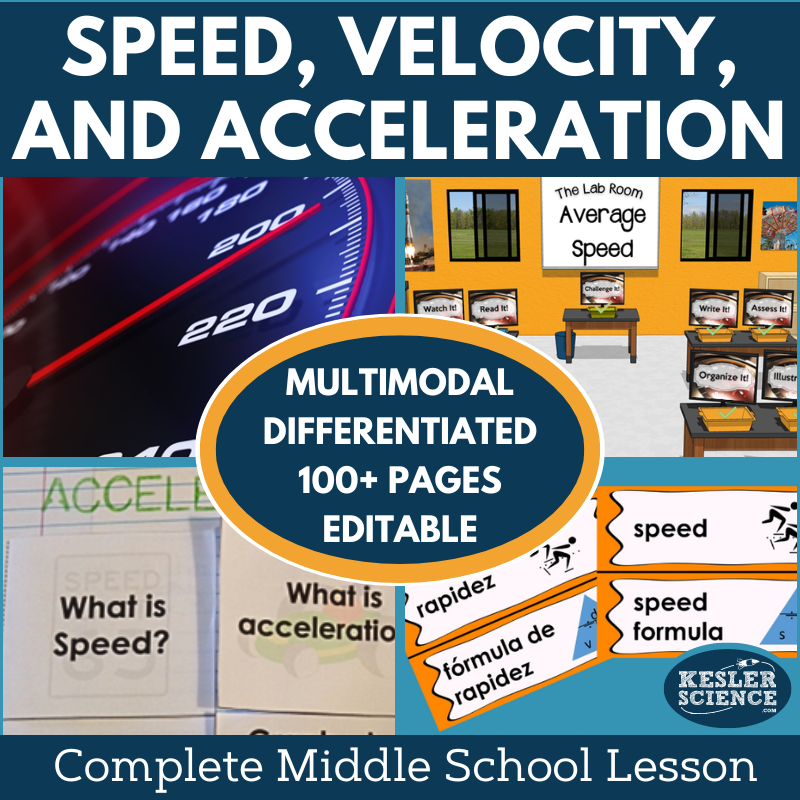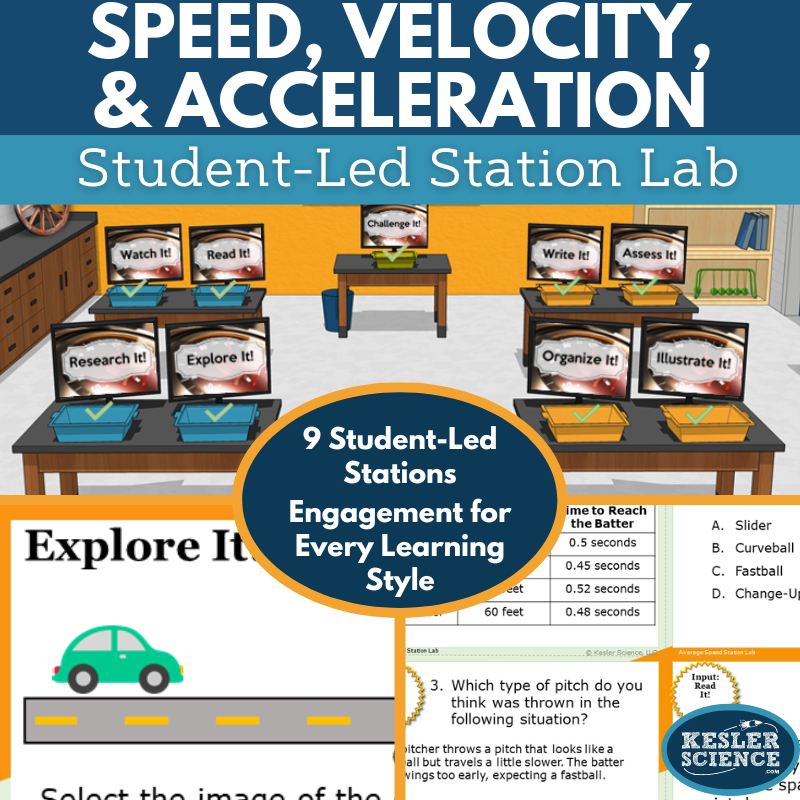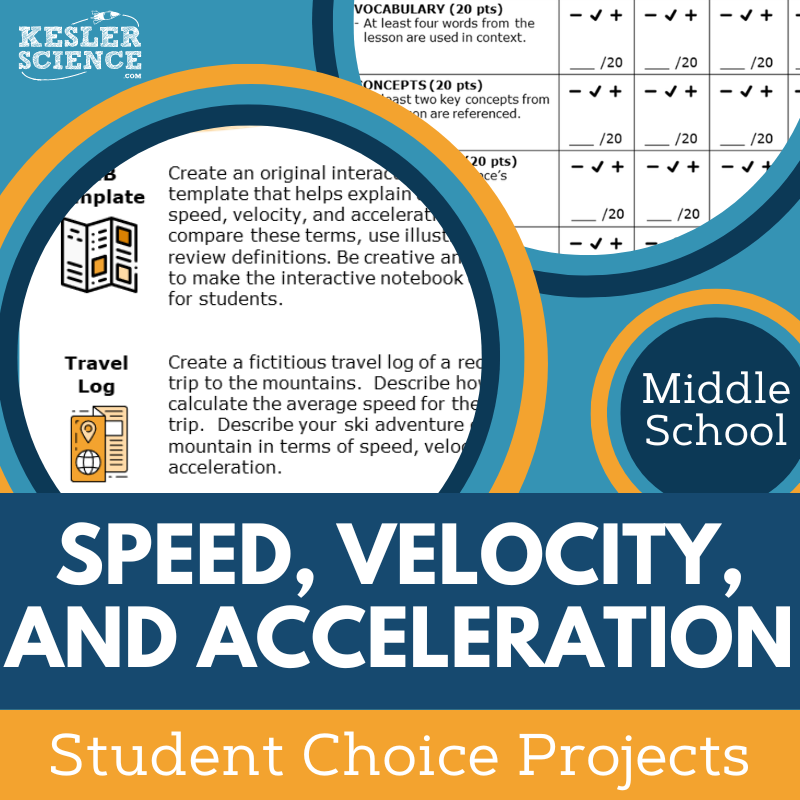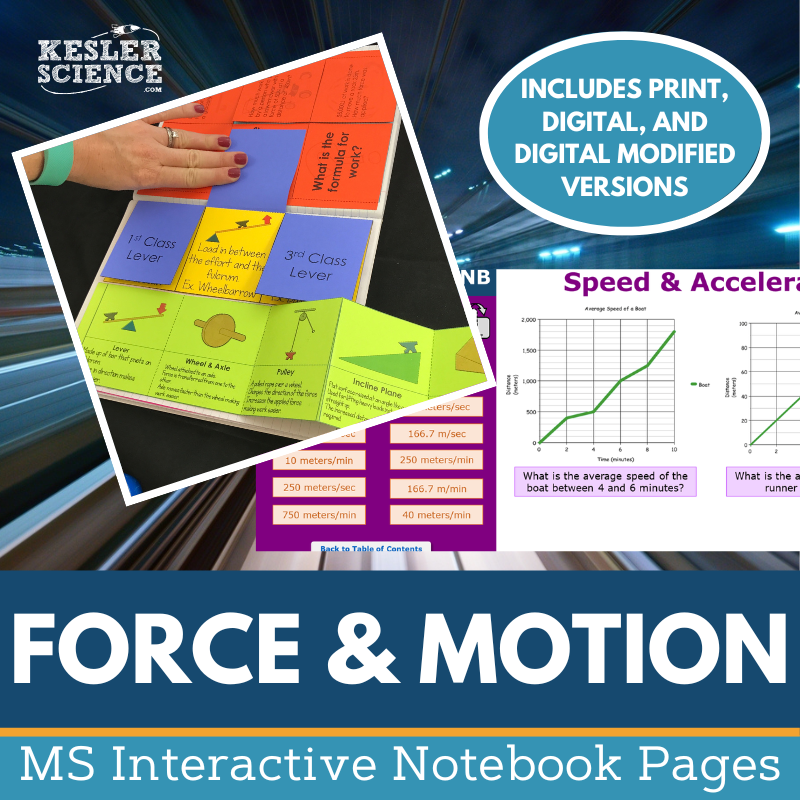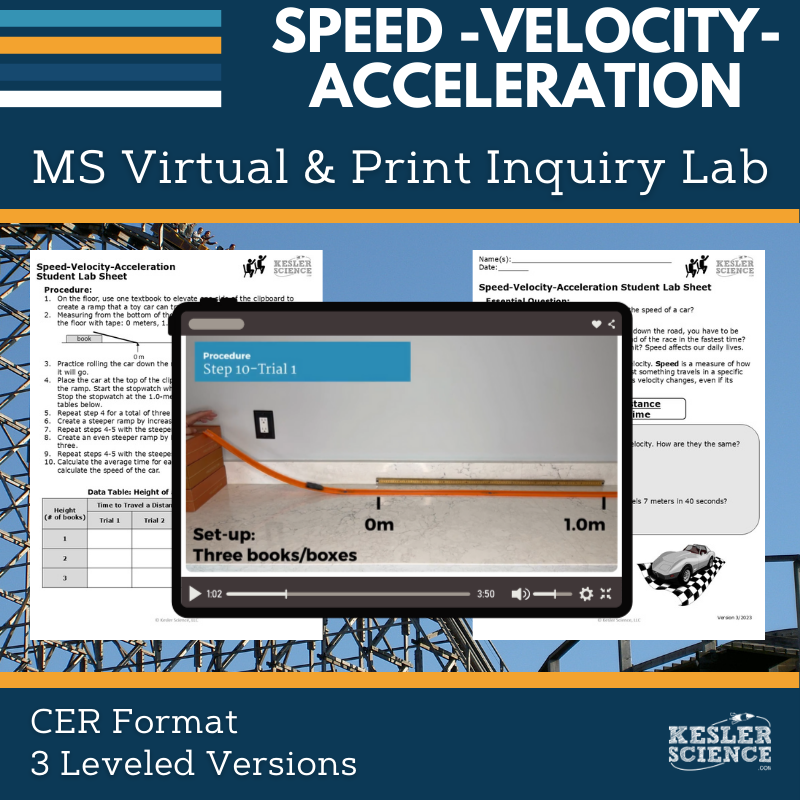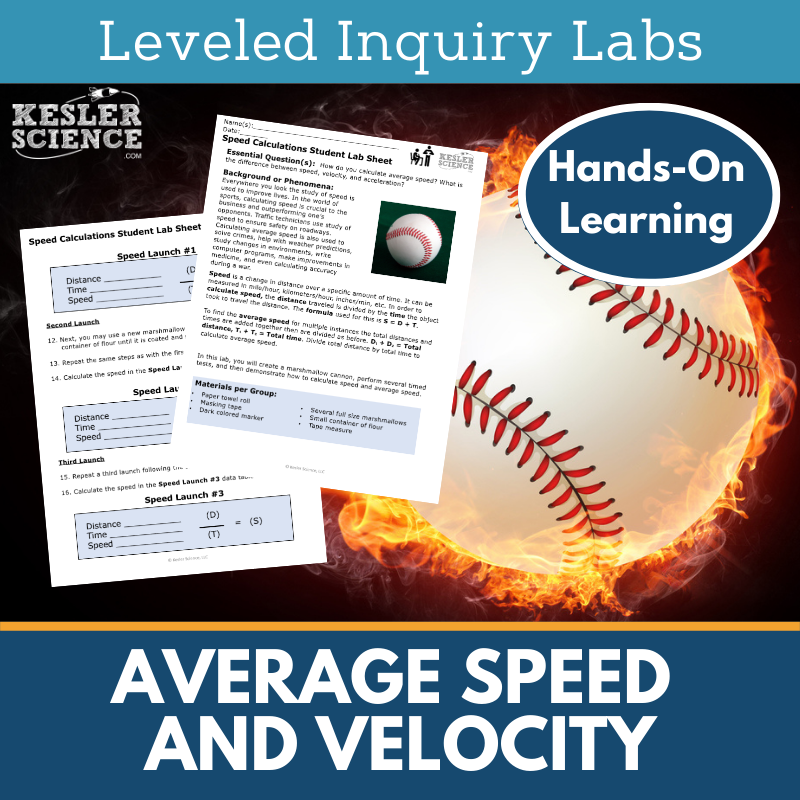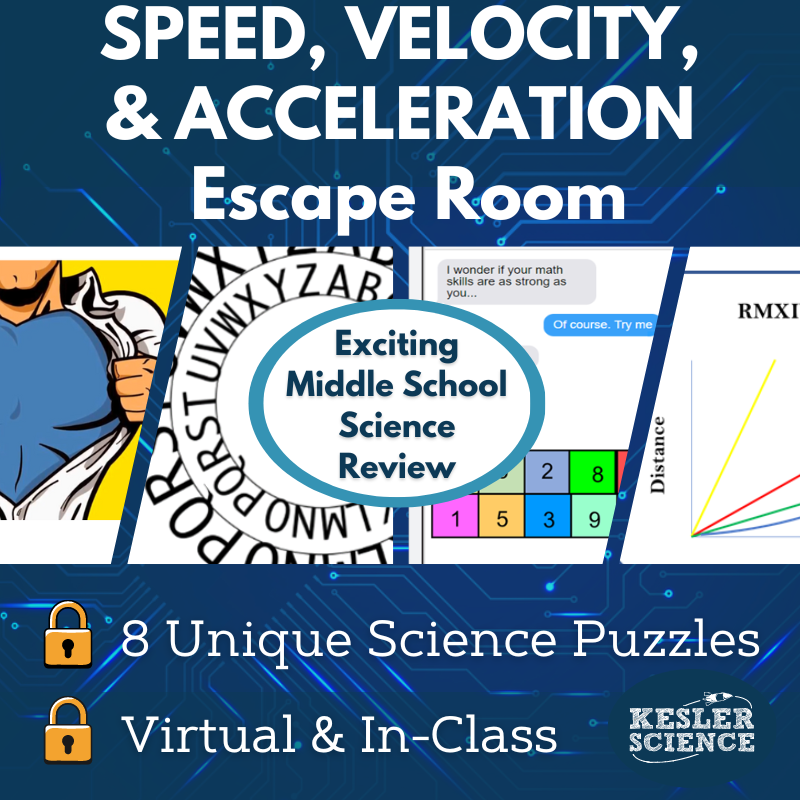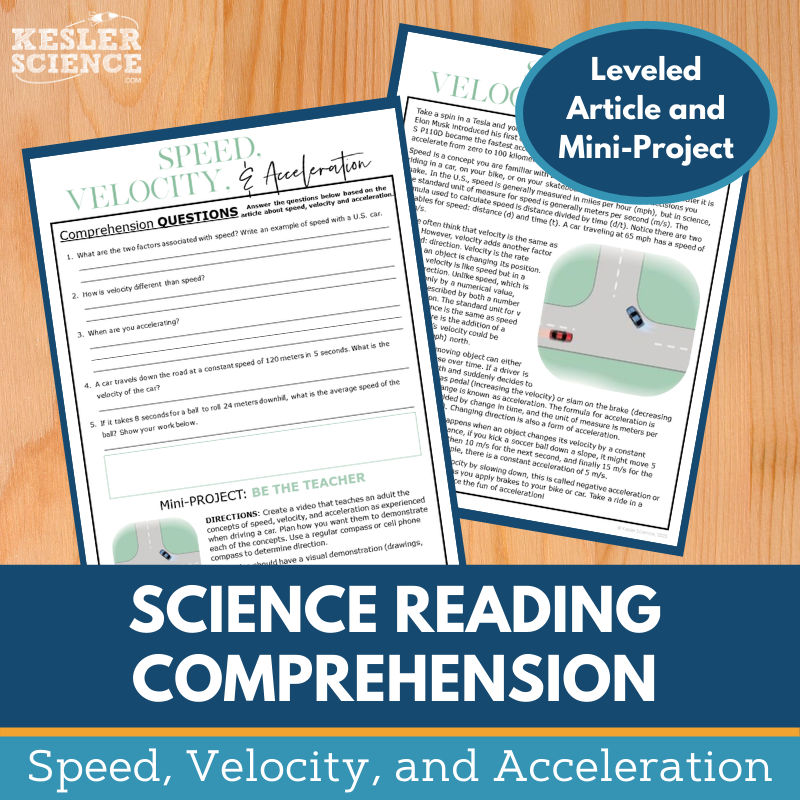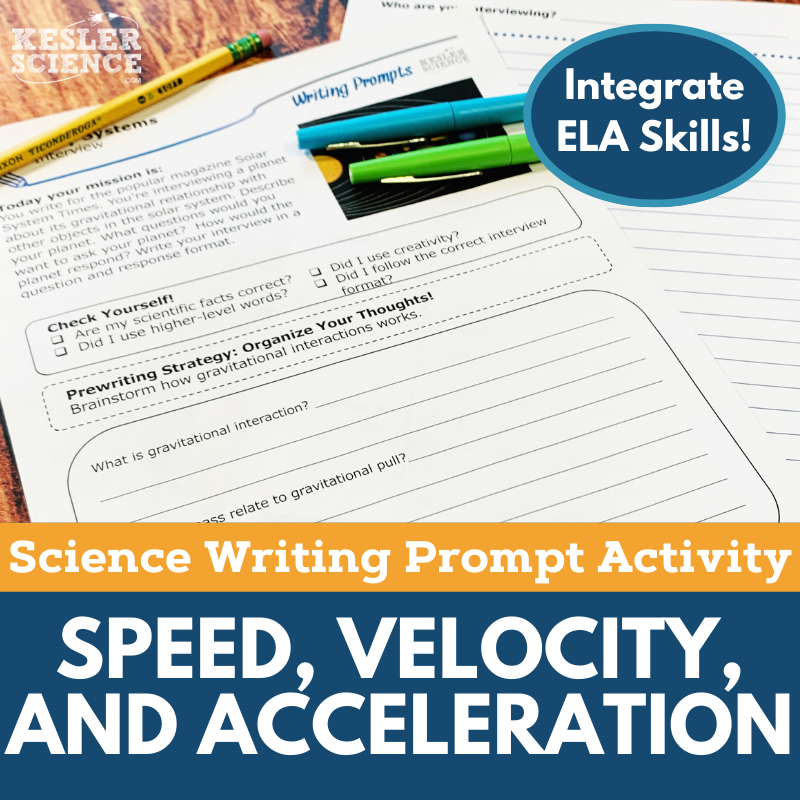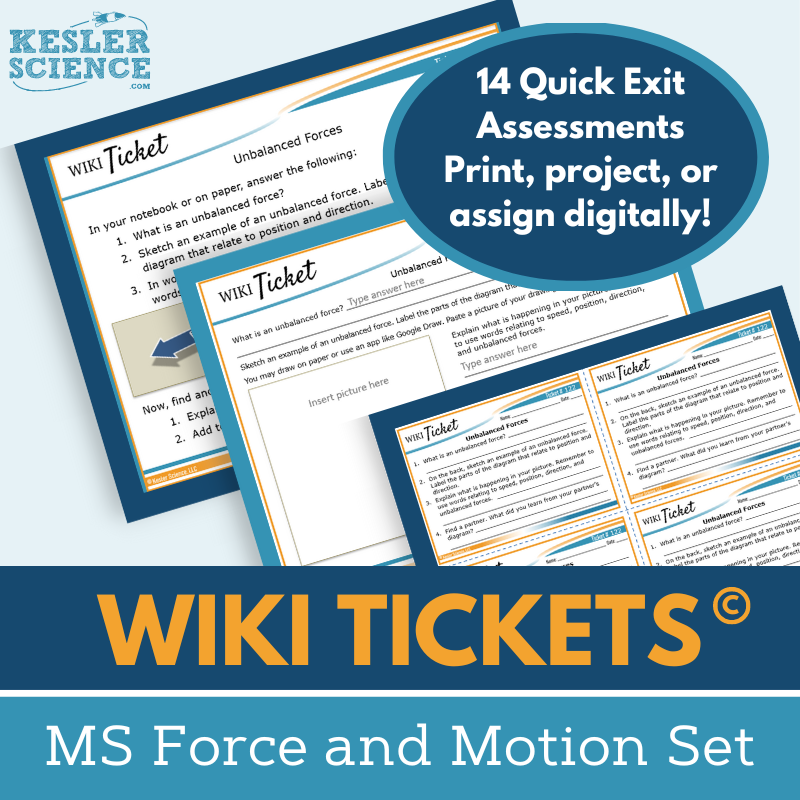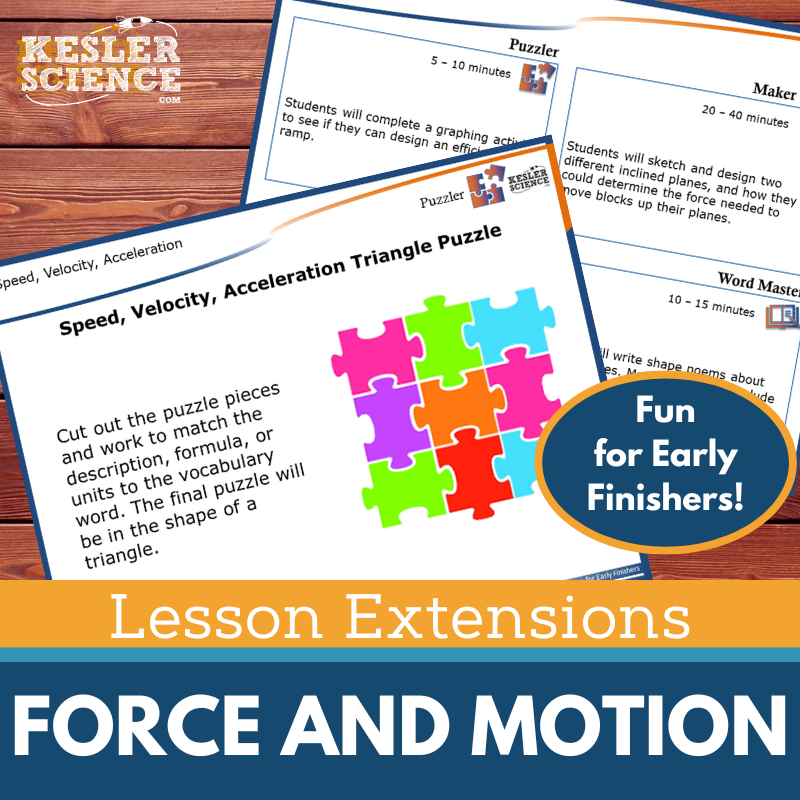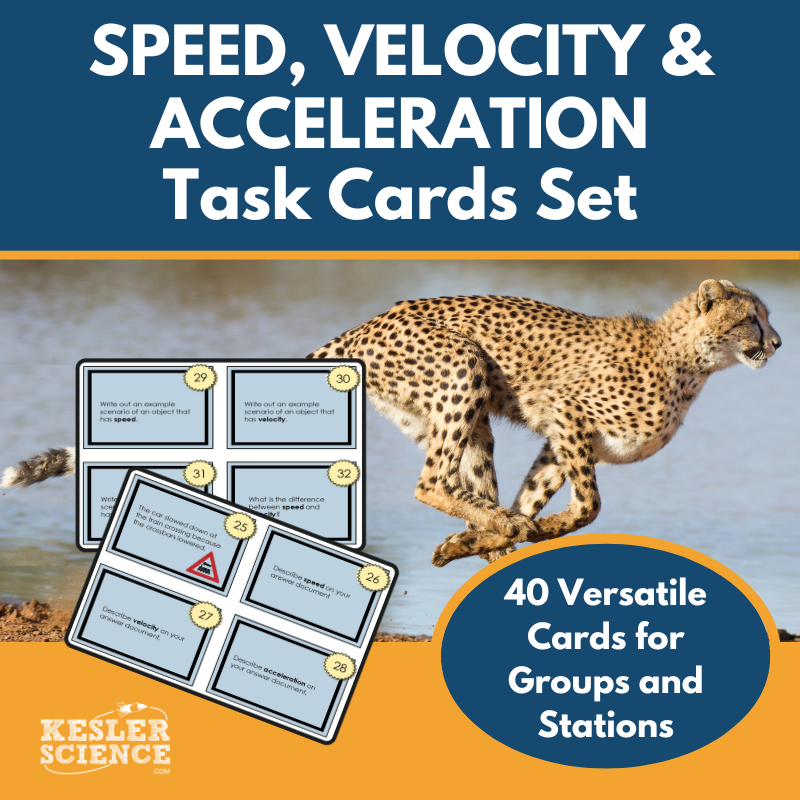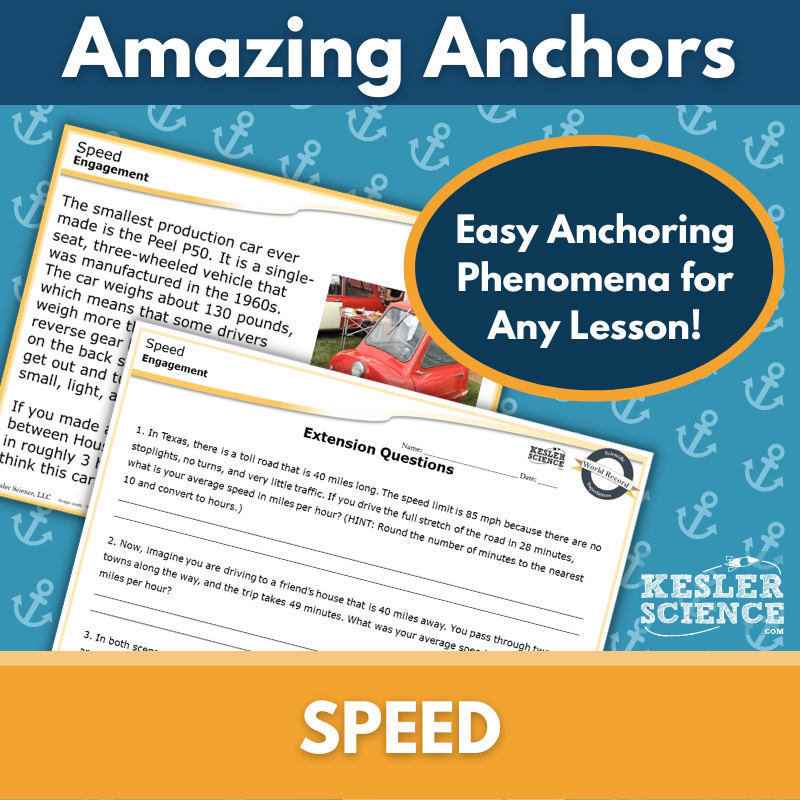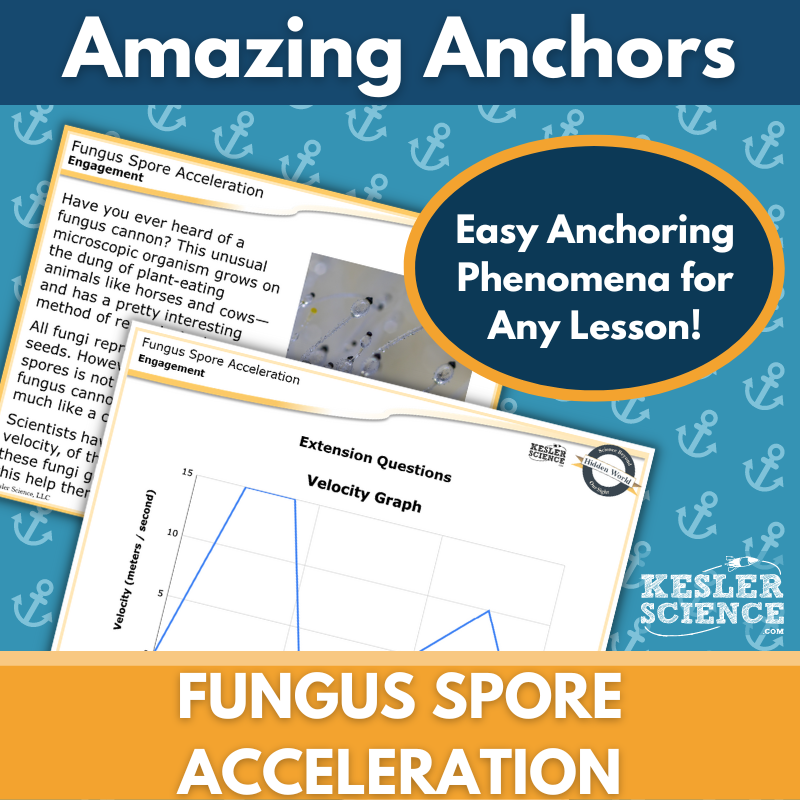Speed, Velocity, and Acceleration Activities for Middle School Science
The Kesler Science Speed, Velocity, and Acceleration resources provide everything you need to teach these key concepts in an engaging and flexible way. The resources below will give students a comprehensive understanding of speed, velocity, and acceleration. All of the following materials are also included in the Kesler Science Membership.
The Kesler Science Speed, Velocity, Acceleration and Average Speed Complete 5E Lesson simplifies lesson planning with everything you need for a dynamic, multi-day learning experience. This comprehensive lesson allows junior high students to explore essential concepts of speed, velocity, and acceleration through a student-led, minimal-prep approach. With flexible, differentiated materials, students engage in multimodal learning and focus on real-world success, making it ideal for varied learning styles.
The lesson follows the 5E Model—Engagement, Exploration, Explanation, Elaboration, and Evaluation—to ensure a thorough understanding of the concepts. Students will answer key questions such as "How do you calculate average speed?" and "What is the difference between speed, velocity, and acceleration?" The materials include vocabulary cards, teacher resources for class activities, and a student-led station lab with differentiated options. Students can choose from hands-on experiments, readings, videos, and interactive tasks, all designed to keep them engaged while reinforcing the learning.
In addition, the lesson offers editable PowerPoints, interactive notebooks, and assessment tools to cater to different student needs. With resources in both English and Spanish, the lesson provides maximum flexibility for diverse classrooms. From the hands-on activities in the stations to the student-choice projects, this complete 5E lesson ensures that middle school students gain a deep understanding of force and motion concepts in a fun, accessible way.
The Kesler Science Speed, Velocity, Acceleration and Average Speed Complete 5E Lesson simplifies lesson planning with everything you need for a dynamic, multi-day learning experience. This comprehensive lesson allows junior high students to explore essential concepts of speed, velocity, and acceleration through a student-led, minimal-prep approach. With flexible, differentiated materials, students engage in multimodal learning and focus on real-world success, making it ideal for varied learning styles.
The lesson follows the 5E Model—Engagement, Exploration, Explanation, Elaboration, and Evaluation—to ensure a thorough understanding of the concepts. Students will answer key questions such as "How do you calculate average speed?" and "What is the difference between speed, velocity, and acceleration?" The materials include vocabulary cards, teacher resources for class activities, and a student-led station lab with differentiated options. Students can choose from hands-on experiments, readings, videos, and interactive tasks, all designed to keep them engaged while reinforcing the learning.
In addition, the lesson offers editable PowerPoints, interactive notebooks, and assessment tools to cater to different student needs. With resources in both English and Spanish, the lesson provides maximum flexibility for diverse classrooms. From the hands-on activities in the stations to the student-choice projects, this complete 5E lesson ensures that middle school students gain a deep understanding of force and motion concepts in a fun, accessible way.
The Kesler Science Speed, Velocity, and Acceleration Station Lab is a student-led, modular activity designed to engage middle school students in learning about speed, velocity, and acceleration. With eight differentiated stations, plus a "Challenge It!" bonus station for early finishers, students calculate average speed through hands-on and digital tasks. Teachers facilitate learning, providing guidance without directing the entire process.
The stations include "Explore It!" for practical application, "Research It!" for online exploration, "Read It!" for differentiated reading passages in English and Spanish, and "Watch It!" for video comprehension. Each station caters to diverse learning styles and abilities, ensuring that all students can engage meaningfully with the material.
In addition to input stations, students demonstrate their knowledge at output stations like "Organize It!" (manipulatives), "Illustrate It!" (sketching models), "Write It!" (short-answer responses), and "Assess It!" (task cards for vocabulary practice). The lab is adaptable for both in-person and virtual classrooms, providing all necessary materials, including task cards and resources for a comprehensive learning experience.
The Kesler Science Speed, Velocity, and Acceleration Station Lab is a student-led, modular activity designed to engage middle school students in learning about speed, velocity, and acceleration. With eight differentiated stations, plus a "Challenge It!" bonus station for early finishers, students calculate average speed through hands-on and digital tasks. Teachers facilitate learning, providing guidance without directing the entire process.
The stations include "Explore It!" for practical application, "Research It!" for online exploration, "Read It!" for differentiated reading passages in English and Spanish, and "Watch It!" for video comprehension. Each station caters to diverse learning styles and abilities, ensuring that all students can engage meaningfully with the material.
In addition to input stations, students demonstrate their knowledge at output stations like "Organize It!" (manipulatives), "Illustrate It!" (sketching models), "Write It!" (short-answer responses), and "Assess It!" (task cards for vocabulary practice). The lab is adaptable for both in-person and virtual classrooms, providing all necessary materials, including task cards and resources for a comprehensive learning experience.
The Kesler Science Speed, Velocity, and Acceleration Student Choice Projects offer middle school students the freedom to select from various project options that suit their strengths and creativity. Students can choose from nine project ideas plus a “design your own” option. A grading rubric is included, allowing assessments by teachers, peers, or students themselves, and can be adjusted for flexibility.
The projects are differentiated to meet diverse needs. The modified version provides three project choices for students requiring more support, while advanced students can be challenged with a combination of projects. The included rubric evaluates vocabulary, concepts, presentation, clarity, and accuracy.
These projects require basic classroom supplies like paper, markers, and scissors, with some options available digitally. Crafting materials may also be needed for building models.
The Kesler Science Speed, Velocity, and Acceleration Student Choice Projects offer middle school students the freedom to select from various project options that suit their strengths and creativity. Students can choose from nine project ideas plus a “design your own” option. A grading rubric is included, allowing assessments by teachers, peers, or students themselves, and can be adjusted for flexibility.
The projects are differentiated to meet diverse needs. The modified version provides three project choices for students requiring more support, while advanced students can be challenged with a combination of projects. The included rubric evaluates vocabulary, concepts, presentation, clarity, and accuracy.
These projects require basic classroom supplies like paper, markers, and scissors, with some options available digitally. Crafting materials may also be needed for building models.
The Kesler Science Force and Motion Interactive Notebook offers a dynamic way to engage students in learning key physics concepts. This resource includes both print and digital versions, making it adaptable for any classroom setting, including traditional, 1:1 environments, and distance learning.
The notebook covers essential topics such as speed, velocity, acceleration, Newton’s laws, simple machines, and motion graphing. The digital version includes a PowerPoint file that can be uploaded to platforms like Google Slides, MS Teams, or Canvas. It also features reflection pages, space for note-taking, and a modified version for students with accommodations.
For in-person learning, the paper version provides blank and pre-filled templates with color photos for easy use. Whether online or in the classroom, the Force and Motion Interactive Notebook is a versatile tool that helps students actively engage with and understand the material.
The Kesler Science Force and Motion Interactive Notebook offers a dynamic way to engage students in learning key physics concepts. This resource includes both print and digital versions, making it adaptable for any classroom setting, including traditional, 1:1 environments, and distance learning.
The notebook covers essential topics such as speed, velocity, acceleration, Newton’s laws, simple machines, and motion graphing. The digital version includes a PowerPoint file that can be uploaded to platforms like Google Slides, MS Teams, or Canvas. It also features reflection pages, space for note-taking, and a modified version for students with accommodations.
For in-person learning, the paper version provides blank and pre-filled templates with color photos for easy use. Whether online or in the classroom, the Force and Motion Interactive Notebook is a versatile tool that helps students actively engage with and understand the material.
The Speed-Velocity-Acceleration Inquiry Lab engages students in exploring how ramp steepness affects the speed of a toy car. Students measure distance and time, calculate speed, and graph their results to investigate the relationship between height and velocity. The lab supports flexible classroom setups with both hands-on and digital formats, including a pre-recorded demonstration video for virtual learners.
Each format offers three differentiated levels—Modified, Dependent, and Independent—to meet the needs of all learners. The Modified version includes structured guidance and sentence stems, the Dependent version features guided inquiry with step-by-step procedures, and the Independent version encourages student-led exploration with minimal teacher direction.
Printable and digital versions are editable and compatible with Google Slides, and include C.E.R. prompts, reflection questions, teacher resources, and answer keys. The hands-on lab requires basic classroom supplies like a toy car, ramp materials, stopwatch, and masking tape, while the digital version provides interactive activities with no materials needed.
The Speed-Velocity-Acceleration Inquiry Lab engages students in exploring how ramp steepness affects the speed of a toy car. Students measure distance and time, calculate speed, and graph their results to investigate the relationship between height and velocity. The lab supports flexible classroom setups with both hands-on and digital formats, including a pre-recorded demonstration video for virtual learners.
Each format offers three differentiated levels—Modified, Dependent, and Independent—to meet the needs of all learners. The Modified version includes structured guidance and sentence stems, the Dependent version features guided inquiry with step-by-step procedures, and the Independent version encourages student-led exploration with minimal teacher direction.
Printable and digital versions are editable and compatible with Google Slides, and include C.E.R. prompts, reflection questions, teacher resources, and answer keys. The hands-on lab requires basic classroom supplies like a toy car, ramp materials, stopwatch, and masking tape, while the digital version provides interactive activities with no materials needed.
The Average Speed and Velocity Inquiry Lab aligns with TEKS standards and engages students in investigating how ramp steepness affects the speed of a toy car. Students measure distance and time, calculate speed, and graph their results on a distance-time chart. The activity requires simple materials and enough space to build a 1-meter racetrack.
Three differentiated versions of the lab are included to meet diverse learning needs: a modified version with structured guidance, a dependent version with guided inquiry, and an independent version for advanced learners who design much of the lab themselves. Each version includes comprehension questions, Claim-Evidence-Reasoning (C.E.R.) prompts, and a reflection section to support scientific thinking.
Teacher resource pages, editable files, answer keys, and a clear materials list make this lab easy to implement. Using common items like a toy car, meter stick, masking tape, and stopwatches, students explore motion in an interactive, hands-on way that builds graphing and data analysis skills.
The Average Speed and Velocity Inquiry Lab aligns with TEKS standards and engages students in investigating how ramp steepness affects the speed of a toy car. Students measure distance and time, calculate speed, and graph their results on a distance-time chart. The activity requires simple materials and enough space to build a 1-meter racetrack.
Three differentiated versions of the lab are included to meet diverse learning needs: a modified version with structured guidance, a dependent version with guided inquiry, and an independent version for advanced learners who design much of the lab themselves. Each version includes comprehension questions, Claim-Evidence-Reasoning (C.E.R.) prompts, and a reflection section to support scientific thinking.
Teacher resource pages, editable files, answer keys, and a clear materials list make this lab easy to implement. Using common items like a toy car, meter stick, masking tape, and stopwatches, students explore motion in an interactive, hands-on way that builds graphing and data analysis skills.
The Kesler Science Speed, Velocity, and Acceleration Escape Room offers an exciting and immersive way for students to engage with these scientific principles. Teachers have complete control over the puzzles they use, with eight independent challenges that can be tailored to fit any class length. This flexibility makes it suitable for both short and long periods.
There are two main ways to run the escape room. The simplest option involves using manila envelopes with all printed materials provided, while a more authentic experience requires additional items like locks and a storage box for securing the puzzles. Either method includes everything needed, including teacher directions and answer keys, along with a variety of digital and print options for students.
New for 2020, the product also offers a digital version for Google Slides, allowing students to solve puzzles online, as well as a print version for families to use at home. With over 50 prize ideas and a variety of materials to enhance the experience, this escape room is a fun and educational activity.
The Kesler Science Speed, Velocity, and Acceleration Escape Room offers an exciting and immersive way for students to engage with these scientific principles. Teachers have complete control over the puzzles they use, with eight independent challenges that can be tailored to fit any class length. This flexibility makes it suitable for both short and long periods.
There are two main ways to run the escape room. The simplest option involves using manila envelopes with all printed materials provided, while a more authentic experience requires additional items like locks and a storage box for securing the puzzles. Either method includes everything needed, including teacher directions and answer keys, along with a variety of digital and print options for students.
New for 2020, the product also offers a digital version for Google Slides, allowing students to solve puzzles online, as well as a print version for families to use at home. With over 50 prize ideas and a variety of materials to enhance the experience, this escape room is a fun and educational activity.
The Kesler Science Speed, Velocity, and Acceleration Reading Comprehension activity helps middle school students explore these key concepts through a nonfiction article, comprehension questions, and a hands-on video project. Students apply what they've learned by creating a video that teaches how speed, velocity, and acceleration are experienced while driving a car.
Designed for grades 6-8 (and higher-level 5th graders), the reading passage comes in two levels with a Lexile range of 1100-1300. The resource includes engaging graphics, 5-7 questions, and a mini-project that enhances science literacy and reading comprehension.
This resource is perfect for both in-person and virtual learning environments, with flexible formats for Google Classroom, MS Teams, and more. It’s ideal for absent students, extra credit, or building routine literacy in science.
The Kesler Science Speed, Velocity, and Acceleration Reading Comprehension activity helps middle school students explore these key concepts through a nonfiction article, comprehension questions, and a hands-on video project. Students apply what they've learned by creating a video that teaches how speed, velocity, and acceleration are experienced while driving a car.
Designed for grades 6-8 (and higher-level 5th graders), the reading passage comes in two levels with a Lexile range of 1100-1300. The resource includes engaging graphics, 5-7 questions, and a mini-project that enhances science literacy and reading comprehension.
This resource is perfect for both in-person and virtual learning environments, with flexible formats for Google Classroom, MS Teams, and more. It’s ideal for absent students, extra credit, or building routine literacy in science.
The Kesler Science Speed, Velocity, and Acceleration Science Writing Prompt Activity offers middle school students a creative narrative to explore key concepts in physical science. Students will develop their understanding of speed, velocity, and acceleration through engaging writing exercises that encourage scientific reasoning.
This low-prep, student-centered activity is ideal for elaboration or review and can be easily integrated with other Kesler Science materials. It provides options for both in-person and virtual learning, ensuring students stay engaged, even outside the classroom.
Included in the product are teacher directions, a digital interactive version, full-sized and half-sheet handouts, as well as rubrics for assessment. This versatile resource can be used for formative assessments, student choice projects, or as differentiation for varied learning needs.
The Kesler Science Speed, Velocity, and Acceleration Science Writing Prompt Activity offers middle school students a creative narrative to explore key concepts in physical science. Students will develop their understanding of speed, velocity, and acceleration through engaging writing exercises that encourage scientific reasoning.
This low-prep, student-centered activity is ideal for elaboration or review and can be easily integrated with other Kesler Science materials. It provides options for both in-person and virtual learning, ensuring students stay engaged, even outside the classroom.
Included in the product are teacher directions, a digital interactive version, full-sized and half-sheet handouts, as well as rubrics for assessment. This versatile resource can be used for formative assessments, student choice projects, or as differentiation for varied learning needs.
The Kesler Science formative Force and Motion WIKI ticket assessments offer flexible, engaging options for checking student understanding. This set includes 14 assessments, each with five formats: a full-screen display version for projection, three handout sizes, and an interactive digital version (PPT or Google Slides). These assessments are aligned with NGSS and TEKS standards, covering topics like speed, unbalanced forces, and Newton’s laws.
WIKI Tickets provide a fun, interactive way to gauge students' progress, perfect for use as exit tickets, bellringers, or formative assessments during lessons. The resource works well in both traditional and virtual learning environments, allowing for easy adaptation to any classroom setting.
Each topic includes multiple formats, making it easy to implement in-person or online. Whether projected in class or completed digitally, these colorful assessments allow for continuous student engagement and real-time understanding checks, helping you monitor student progress throughout the unit.
The Kesler Science formative Force and Motion WIKI ticket assessments offer flexible, engaging options for checking student understanding. This set includes 14 assessments, each with five formats: a full-screen display version for projection, three handout sizes, and an interactive digital version (PPT or Google Slides). These assessments are aligned with NGSS and TEKS standards, covering topics like speed, unbalanced forces, and Newton’s laws.
WIKI Tickets provide a fun, interactive way to gauge students' progress, perfect for use as exit tickets, bellringers, or formative assessments during lessons. The resource works well in both traditional and virtual learning environments, allowing for easy adaptation to any classroom setting.
Each topic includes multiple formats, making it easy to implement in-person or online. Whether projected in class or completed digitally, these colorful assessments allow for continuous student engagement and real-time understanding checks, helping you monitor student progress throughout the unit.
The Kesler Science Force and Motion Lesson Extensions are designed to engage fast finishers with critical thinking and creativity. These activities offer a mix of rigor and fun, providing an ideal way to wrap up lessons or keep students occupied during testing. The activities help deepen understanding of force and motion while aligning with NGSS and TEKS standards.
Each extension includes four different types of activities: Puzzler, Maker Space, Tech Connection, and Word Master. These activities are student-driven, allowing for personalized learning experiences. Whether it’s solving puzzles, building models, exploring digital media, or expressing ideas through creative writing, each activity promotes critical thinking and hands-on engagement.
These extensions come with teacher directions, answer keys, and printable versions. The materials are flexible, allowing for use in both digital and in-person settings. Perfect for advanced learners or as supplementary activities, they provide a structured yet engaging way to dive deeper into topics like gravity, Newton’s laws, and speed.
The Kesler Science Force and Motion Lesson Extensions are designed to engage fast finishers with critical thinking and creativity. These activities offer a mix of rigor and fun, providing an ideal way to wrap up lessons or keep students occupied during testing. The activities help deepen understanding of force and motion while aligning with NGSS and TEKS standards.
Each extension includes four different types of activities: Puzzler, Maker Space, Tech Connection, and Word Master. These activities are student-driven, allowing for personalized learning experiences. Whether it’s solving puzzles, building models, exploring digital media, or expressing ideas through creative writing, each activity promotes critical thinking and hands-on engagement.
These extensions come with teacher directions, answer keys, and printable versions. The materials are flexible, allowing for use in both digital and in-person settings. Perfect for advanced learners or as supplementary activities, they provide a structured yet engaging way to dive deeper into topics like gravity, Newton’s laws, and speed.
The Speed, Velocity, and Acceleration Task Card set helps students differentiate between these three key motion concepts through real-world scenarios. With 40 engaging task cards, this activity can be used flexibly in station labs, small groups, or as a whole-class review.
The resource includes a student data sheet for recording answers and a teacher key for quick grading and reference. This hands-on activity supports students in developing a clear understanding of speed, velocity, and acceleration through applied practice.
The Speed, Velocity, and Acceleration Task Card set helps students differentiate between these three key motion concepts through real-world scenarios. With 40 engaging task cards, this activity can be used flexibly in station labs, small groups, or as a whole-class review.
The resource includes a student data sheet for recording answers and a teacher key for quick grading and reference. This hands-on activity supports students in developing a clear understanding of speed, velocity, and acceleration through applied practice.
The Amazing Anchors Phenomenon Lesson introduces and reinforces the concept of speed through a real-world connection involving a surprisingly small car. Students begin with an engaging introductory reading and respond to comprehension and extension questions to activate prior knowledge. A second reading explains the science of speed in clear, accessible language, followed by questions that deepen understanding and support classroom discussion.
This TEKS-aligned resource includes teacher directions, answer keys, and editable materials available in both print and digital formats. Full-page projection slides and printable handouts make it easy to implement in various classroom settings, whether in-person or virtual. The lesson is ideal for the Engagement and Elaborate stages of the 5E Instructional Model.
To support all learners, the lesson includes differentiated versions: a dependent version for on-level students and a modified version that provides sentence starters and simplified language. These flexible tools ensure that students of different ability levels can successfully engage with and apply the concept of speed.
This Amazing Anchors Phenomenon Lesson introduces and reinforces the concept of speed through a real-world connection involving a surprisingly small car. Students begin with an engaging introductory reading and respond to comprehension and extension questions to activate prior knowledge. A second reading explains the science of speed in clear, accessible language, followed by questions that deepen understanding and support classroom discussion.
This TEKS-aligned resource includes teacher directions, answer keys, and editable materials available in both print and digital formats. Full-page projection slides and printable handouts make it easy to implement in various classroom settings, whether in-person or virtual. The lesson is ideal for the Engagement and Elaborate stages of the 5E Instructional Model.
To support all learners, the lesson includes differentiated versions: a dependent version for on-level students and a modified version that provides sentence starters and simplified language. These flexible tools ensure that students of different ability levels can successfully engage with and apply the concept of speed.
This Amazing Anchors Phenomenon Lesson introduces and reinforces the concepts of velocity and acceleration through the fascinating real-world example of fungus cannons. Students begin with an introductory reading designed to spark curiosity, followed by comprehension and extension questions. A second explanatory reading breaks down the science behind how fungus cannons accelerate and reach high velocities, with additional questions to deepen understanding.
The TEKS-aligned resource includes teacher directions, answer keys, and editable materials in both print and digital formats. Full-page projection slides and printable handouts make it flexible for in-person or virtual learning. This resource is ideal for the Engagement and Elaborate phases of the 5E Instructional Model.
Differentiated versions are included to support diverse learners. The dependent version is suited for on-level students, while the modified version offers scaffolds like sentence starters and simplified language to help students succeed with comprehension tasks.
This Amazing Anchors Phenomenon Lesson introduces and reinforces the concepts of velocity and acceleration through the fascinating real-world example of fungus cannons. Students begin with an introductory reading designed to spark curiosity, followed by comprehension and extension questions. A second explanatory reading breaks down the science behind how fungus cannons accelerate and reach high velocities, with additional questions to deepen understanding.
The TEKS-aligned resource includes teacher directions, answer keys, and editable materials in both print and digital formats. Full-page projection slides and printable handouts make it flexible for in-person or virtual learning. This resource is ideal for the Engagement and Elaborate phases of the 5E Instructional Model.
Differentiated versions are included to support diverse learners. The dependent version is suited for on-level students, while the modified version offers scaffolds like sentence starters and simplified language to help students succeed with comprehension tasks.
Year-Round Resources
These year-round activities will increase your students' understanding of many middle school science topics. All of these activities are also included in the Kesler Science Membership.
Visual Data & Graphing
You're not alone if your students struggle with understanding graphs, charts, and tables. It's a skill that takes an enormous amount of practice. This resource will help students build a strong foundation in analyzing data and creating their own data visualizations.
Bell Ringers and Warm-Ups
These middle school science bell ringers are an excellent way to engage your students as soon as they walk into your classroom. This comprehensive FULL YEAR resource includes everything you need to start off each science class with an interesting warm-up activity.
Review Board Games
Each game board has been carefully designed to keep students engaged. There are 10 different action spaces on each board and dozens of question cards. All of the actions are related to science concepts and keep the students motivated throughout the game.
Each game is ready to play. Simply print out the board and the cards and let the students enjoy reviewing nine different units.
Essential Questions
Below are the essential questions associated with the lessons and activities included in this unit. This topic is only one of more than 100 middle school science topics included in the Kesler Science Membership.
-
How do you calculate average speed?
-
What is the difference between speed, velocity, and acceleration?
Kesler Science Membership
Imagine never having to search for another middle school science lesson again. The membership gives you access to ALL of the Kesler Science products in one place (Yes, including everything above).
Say goodbye to long hours of lesson prep.

